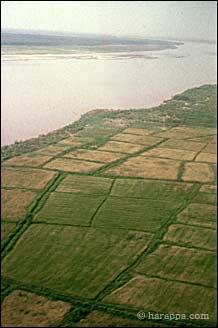Site Location
The site is located in the semi-arid region of Sindh province, Pakistan, and situated on a Pleistocene ridge that sits like an island in the flood plain of the Indus River.
Although the ridge is now deeply buried by the annual flooding that inundated the plain, it may have been more prominent in the prehistoric period, with the early city standing out above the surrounding plain.
Eventually through the build up of occupation debris and the construction of massive mud brick platforms, the settlement grew to monumental proportions, with high mounds reaching as high as 12 meters above the modern plain level, and probably much higher above the ancient plain.
The site appears to have been located in a central position between the two vast river valleys, the Indus on the west and the Ghaggar-Hakra on the east that would have flowed to the east of the Rohri hills.
Today the Indus flows to the east of the site and the Ghaggar-Hakra riverbed is dry. The drying up of one river and the shifting of the Indus across the site were undoubtedly major factors contributing to the decline of the ancient city.
In its heyday however, Mohenjo-daro would have dominated the riverine trade networks moving from the coast to the northern Indus plain, as well as trade routes leading to the passes in the Bolan Valley to the west.
Site Organization/Settlement Planning
Mohenjo Daro is by far the largest of the Indus cities, extending over 250 hectares with widespread mounds and outlying habitation areas.
It is one of the best-preserved urban centers of the Indus Civilization (2600-1900 BCE) and the only other comparable site is Dholavira, Kutch, India.
The buildings of Mohenjo-daro are made primarily of fired brick, though some structures do include mud brick and timbers.
Mohenjo-daro was spared the looting of bricks that destroyed Harappa and most sites in the Punjab because the main railroad line was constructed along the east bank of the Indus and crushed rock from the Rohri hills was easily accessible for constructing the rail bed.


